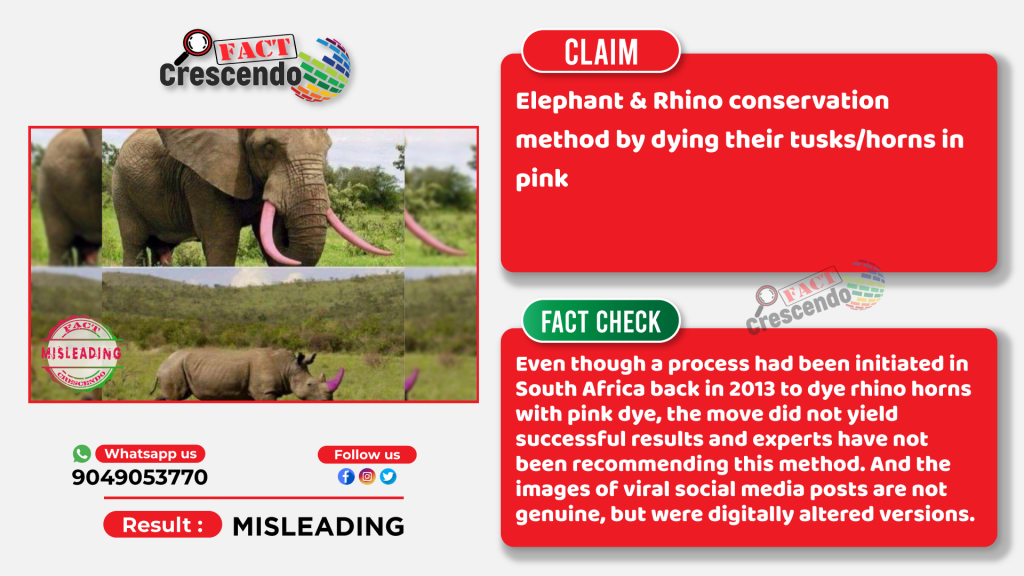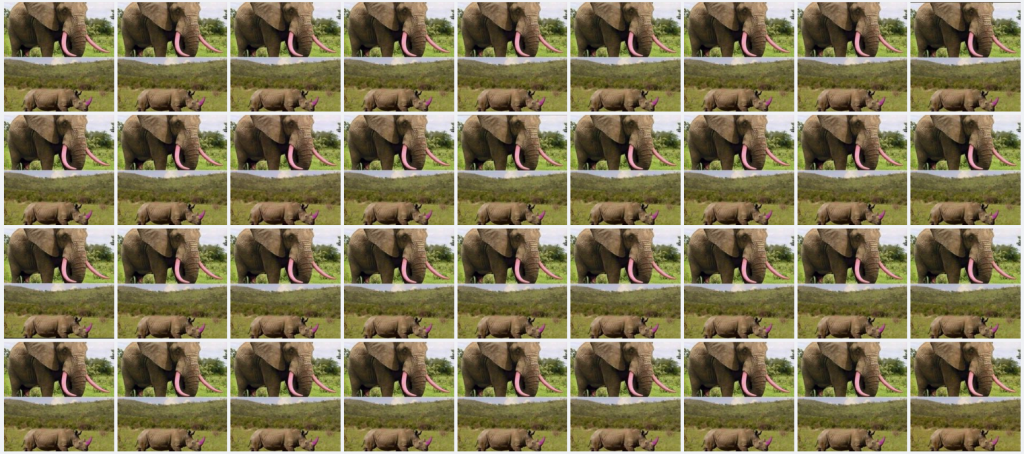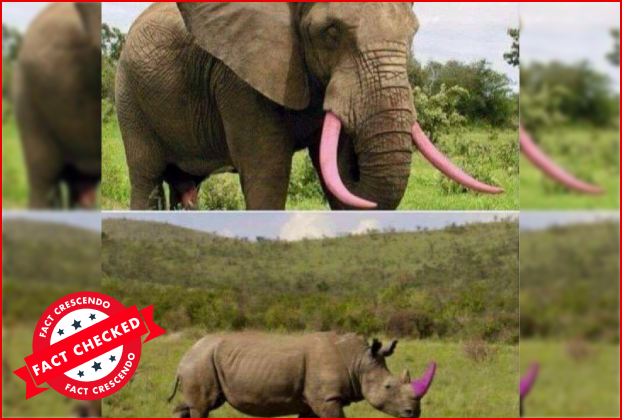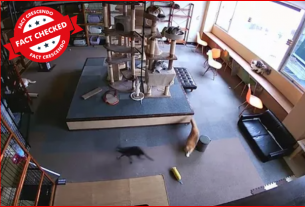
Conservation of tuskers has become a serious issue as the rate of illegal trading mafias of ivory/horn and poaching methods have increased significantly. In such a context, environmentalists and animal lovers throughout the world have voiced their concerns over the safety of tusker elephants, rhinos etc. and have been considering modern conservation methods.
In this regard, we came across a recurring claim which said that the tusks and horns were dyed in pink color to discourage illegal traders from hunting these animals. However, our investigation found these claims to be misleading.
Social Media Posts
Social media posts claimed that pink dye was used on horns/tusks of rhinos and elephants, as a major conservation process by conservationists. It is said that such dyeing would depreciate the value of ivory/horns and in turn save the lives of these giants.
Below is one such Facebook post which got shared recently with the below caption.
“One of the best things I’ve seen in a while. They use the same pink dye that is attached to stolen bank notes. This makes the ivory unsellable, and it cannot be consumed. The animals are not harmed and it is saving their lives.”

Below are some of the comments to these posts.

Posts were viral among Facebook users as seen below.

Fact Check
A reverse image search results showed that the Rhino image was an altered version, yet there had been an initiative to dye the Rhino horns several years back with the aim of saving these animals from poachers. “Save the Rhino” website and published the image of the Rhino and explains about a project reported called “Takepart” in 2013.
Project to Dye Rhino Horns in 2013
An archived version of “Takepart” article says about efforts of a group in 2013 to initiate such a project in a private game reserve in South Africa to deter the poachers and save the rhinos. The article says that the project injected a red dye and ectoparasitic toxin, into the horns of rhinos which made the horns appear pink. It further reveals that the dye injected into rhino horns was meant to be highly poisonous to humans and not to the rhinos.
An AFP video about this project at its initiation phase can be watched here. More details on this can be taken from here | Archived.
“Save The Rhino” article says that due to a variety of reasons such as the dye not lasting long enough and the growth of the horns etc. meant that the initiative wasn’t as successful as reported here | Archived
According to a report in 2014, the dye did not permeate the entire horn like that of the edited photo and the practicality of the initiative was limited due to the complex nature of the process. The report reveals that it takes around 90 minutes for the treatment and only 4 rhinos can be treated in a large park per day and approaching the animals for the process is also risky. And they recommend that conservationists should not use this process.
Fact-Check: Have White Rhinos gone extinct…? No, here’s the fact
Altered images of Rhino & Elephant
The original image of the rhino seen in Facebook posts had been captured by photographer Heinrich van den Berg in South Africa as seen here | Archived. You can see the photo comparison below with the original photo and the pink colored altered version.

Even though there was a project initiated to dye the rhino horns, we did not come across any such initiative related to elephant tusks as the social media posts claimed.
Hence, we did a reverse image search for the elephant image as well, and found out that the elephant’s photo was also digitally altered. The original image frame can be seen in the below video from 2011, without any coloring.
Hence, it`s clear that both the images of Rhino and Elephant seen in the viral posts were edited and not genuine.
No record of Elephant tusks being dyed
We contacted Dr. Prithiviraj Fernando, one of the prominent conservationists in Sri Lanka to get his views regarding the possibilities of dyeing elephant tusks. He said that the process is very difficult to implement practically. He pointed out that capturing the animals for anesthetization is really challenging for such a process in any country and this has not been implemented as a major conservation process.
Reasons why dyeing would fail as a sustainable solution to poaching
International Fund for Animal Welfare (IFAW) lists number of reasons why this creative approach of dyeing horns/ tusks would fail as a sustainable solution to deter poachers.
A rhino can regenerate its entire horn within 3 years and an Elephant’s tusks can grow as fast as an inch per year. Hence, the dye would grow out and re-dyeing each and every animal every few years is unrealistic.
Apart from sedating and logistical issues described above also, mass scale dyeing if it were to be implemented, would significantly increase the demand for “Pure” rhino horns as well. More on these practical issues of dyeing horns/ tusks of animals can be seen here | Archived
We also noticed that as a last resort some had even decided to chop off rhino horns to help save them from poachers as seen here
Dyeing bank notes
We also searched if there was any system in which the banks used pink dye to recover stolen money. There is such a system, but not necessarily using pink dye. More details about the Intelligent banknote neutralization system (IBNS) can be read here. Archived.
“An intelligent banknote neutralization system (IBNS) is a security system which protects valuable items by rendering them unusable or easily detectable if an unauthorized individual tries to gain access to them. Dye packs are commonly used to safeguard currency against bank robberies in this manner; when such a pack is taken out of the bank, it releases an indelible dye that stains the money with a conspicuous bright color, making it easy to recognize as stolen. Bonding agents (glues) have been used more recently as alternative degradation agents.”
Here is another article describing how a “dye pack” would function during a bank robbery and Rhino Rescue Project (RRP) does indeed state that the dye used to stain stolen bank noted and horns are indeed quite similar as well.
Fact checks done by other institutes for similar claims can be read here and here.
Follow us and stay up to date with our latest fact checks.
Facebook | Twitter |Instagram | Google News |TikTok
Conclusion
Our investigation reveals that making rhino and elephant tusks/horns into pink color is not a sustainable solution to mitigate illegal poaching of these animals. Even though a process had been initiated in South Africa back in 2013 to dye rhino horns with pink dye, the move did not yield successful results and experts have not been recommending this method. And the images of viral social media posts were digitally altered and not genuine.

Title:Elephant & Rhino conservation method by dyeing their tusks/horns in pink? Find out the truth……
Fact Check By: Kalana KrishanthaResult: Misleading





